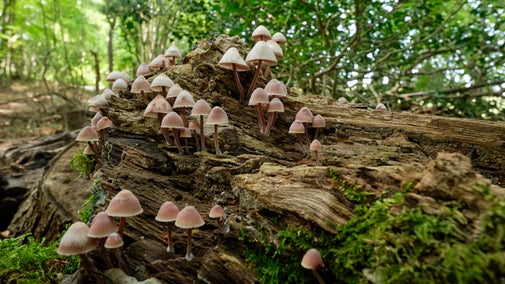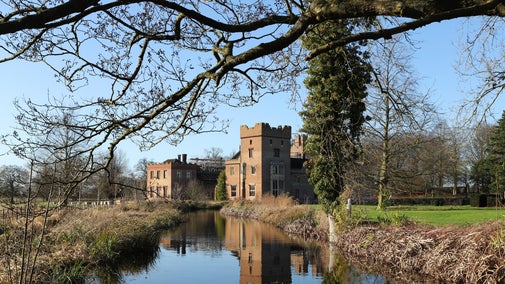
Donate
Everyone needs nature, now more than ever. Donate today and you could help people and nature to thrive at the places we care for.

The Countryside Stewardship project is one of the largest in the island’s history, aiming to create better conditions for nature to thrive and provide a more sustainable future for the species dependent on Brownsea's varied habitat. Here you can find out more about the work being undertaken.
Brownsea's Countryside Stewardship project is a five-year conservation initiative that's funded by Natural England. The scheme provides financial incentives for farmers, woodland owners, foresters and land managers to look after and improve the environment.
Through this project, we aim to improve, expand and link up existing wildlife-rich areas of Brownsea, with a focus on improving the condition of heathland and woodland, and driving nature recovery for the species that live here.
Capital works including habitat management and track improvements began in September 2021 and were completed in January 2023. The remainder of the five-year project will focus on controlling regeneration of invasive species and additional habitat creation works. Species-rich grassland is also set to be better managed as part of the project.
Brownsea plays a crucial role as a haven for wildlife in Poole Harbour within the recently designated Purbeck Heaths National Nature Reserve (NNR) – the largest lowland heathland nature reserve in England – and that's very much been at the heart of this project.
Greater gains for nature can be made by working at a landscape scale in conjunction with neighbouring land managers, and here on Brownsea that includes working with our partners on the island and the neighbouring Purbeck portfolio, to make bigger, better and more joined up spaces and corridors for wildlife to flourish.
This new super NNR ‘knits’ together 11 types of priority habitat, giving greater protection for wildlife in an area similar in size to Blackpool. With the increasing need for a bigger, better and more joined-up approach to nature conservation, seven leading partners have come together to help protect wildlife by creating the UK’s first ever ‘super’ National Nature Reserve (NNR) on the Purbeck Heaths in Dorset.
It will allow rare and varied wildlife, including the sand lizard, the Dartford warbler, and the silver studded blue butterfly, the freedom to move around creating a better chance of adapting and thriving in light of the current climate crisis.
Purbeck Heaths is one of the most biodiverse places in the UK – home to thousands of species of wildlife, including 450 that are listed as rare, threatened or protected. Indeed, Purbeck includes the richest recorded 10km square for biodiversity in the UK.
By working together and combining land, expertise and a common vision, the National Trust, Natural England, RSPB, Forestry England, the Rempstone Estate, Dorset Wildlife Trust and Amphibian and Reptile Conservation, along with other landowners and managers, are taking important strides forward in landscape-scale conservation and nature recovery.
For more information visit: dorsetaonb.org.uk/project/wild-purbeck
Nationally, the Trust's Land Outdoors and Nature strategy has set out ambitious plans to help reverse the decline in wildlife on all the land in our care as we aim to create or restore 25,000 hectares of habitat by 2025 – the equivalent of more than 33,000 Premier League football pitches.
Heathland and woodland restoration on Brownsea as part of this project will count towards these ambitions.
The improvement works that have been carried out on Brownsea also represent the culmination of a long-held ambition to tackle and eradicate invasive species such as holm oak and rhododendron, inherited by the National Trust on Brownsea six decades ago.

All of the selected tree felling as part of the project has now been completed, creating open spaces that let in more light which will help the heather to grow and spread. 2,000 tonnes of timber has been taken off the island, and nearly all of the remaining stumps have been removed. This will ensure that nutrients aren’t added to the soil and will aid the regeneration of nutrient poor-loving heathland habitat
Continued maintenance will be needed to control bracken, rhododendron, and pine from returning. The remaining roots and branches have been scraped away exposing soil that has a good mixture of organic and mineral material.
Now that light is reaching the bare ground, small sprigs of heather are beginning to emerge, a sure sign that the project to create more wooded heath habitat is starting to work.
Over 4.000 tonnes of gravel was delivered to the island and most of the tracks have now been re-surfaced. This means getting round the island has beome easier, especially for our mobility vehicle the Squirrel shuttle and for the all terrain pushcahirs and wheelchairs.

Heathland is a precious habitat, rarer than rainforest with more than 80 per cent of lowland heathland being lost since 1800. If not managed, it can be lost to dense areas of pioneer tree species like Scots pine and birch.
As well as being rich in biodiversity, heathlands store carbon, and contain among the hightest amounts of carbon per unit area of any habitat, with soil stocks of up to 374 tonnes per hectare. Protection of heathland habitat is therefore not only important for biodiversity, but the carbon stocks they hold, as both may have taken centuries to accumulate.
By avoiding clear felling in heathland restoration and undertaking selective thinning instead, we've been able to manage the landscape as part of this project to improve the priority heathland habitat and maintain carbon stocks.
– Ben Beacham, Countryside Stewardship Project Manager and Lead Ranger, Brownsea Island
A red squirrel habitat assessment took place in 2019 and highlighted the benefits of selective woodland thinning in improving woodland health for red squirrels. Thinning not only allows for regeneration of younger trees and improves the ecological and structural diversity of woodland to ensure continuity into the future, but also creates more space in the canopy, enabling trees to form larger crowns and produce a larger yield of seeds as food.
We have many of the beneficial tree species already on the island: pedunculate (English) oaks, rowan, hawthorn and yew, as well as shrub layer species like bell and cross-leaved heathers, ling and gorse. But the thinning of tight pine stands, in conjunction with controlling invasive species, will mean we will start to see natural regeneration of these more beneficial, native species.

Visitors returning to the island will be able to see the impact that the project has had here in places across the island. Areas that have had targeted tree works will appear more open, letting light into the woodland floor and while it is still early days, there's already some really promising signs of heathland regeneration as a result of the works.
Penelope Park down at the western end of the island is a good place to see the benefits that this conservation work will eventually bring and is a good example of a wooded heath habitat that's been created through similar management over the last 10 years.

Everyone needs nature, now more than ever. Donate today and you could help people and nature to thrive at the places we care for.

Natural England is the government’s adviser for the natural environment in England. They help to protect and restore our natural world.
Discover how a team from the National Trust support the woodland residents on Brownsea Island, Dorset.

Take a walk on Brownsea Island, Dorset, and encounter a variety of birds and other wildlife that calls this island sanctuary in Poole Harbour, home.

Discover how we work to support a rich variety of land, nature and wildlife across England, Wales and Northern Ireland.

Find out more about the funding the National Trust receives from grants, and the projects it has helped support.

With support from the Government’s Green Recovery Challenge Fund, we're looking for ways to protect our environment and combat climate change. Find out more about the work we're doing.

We believe that nature, beauty and history are for everyone. That’s why we’re supporting wildlife, protecting historic sites and more. Find out about our work.
